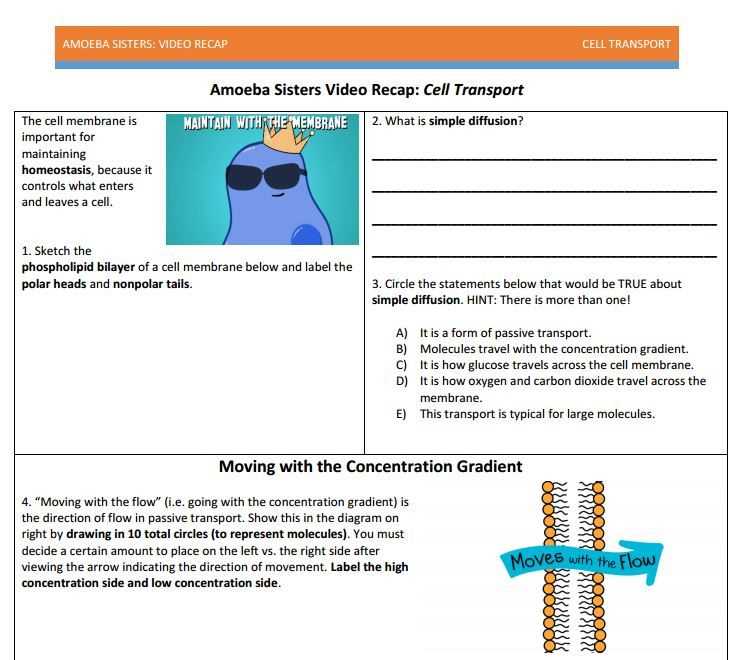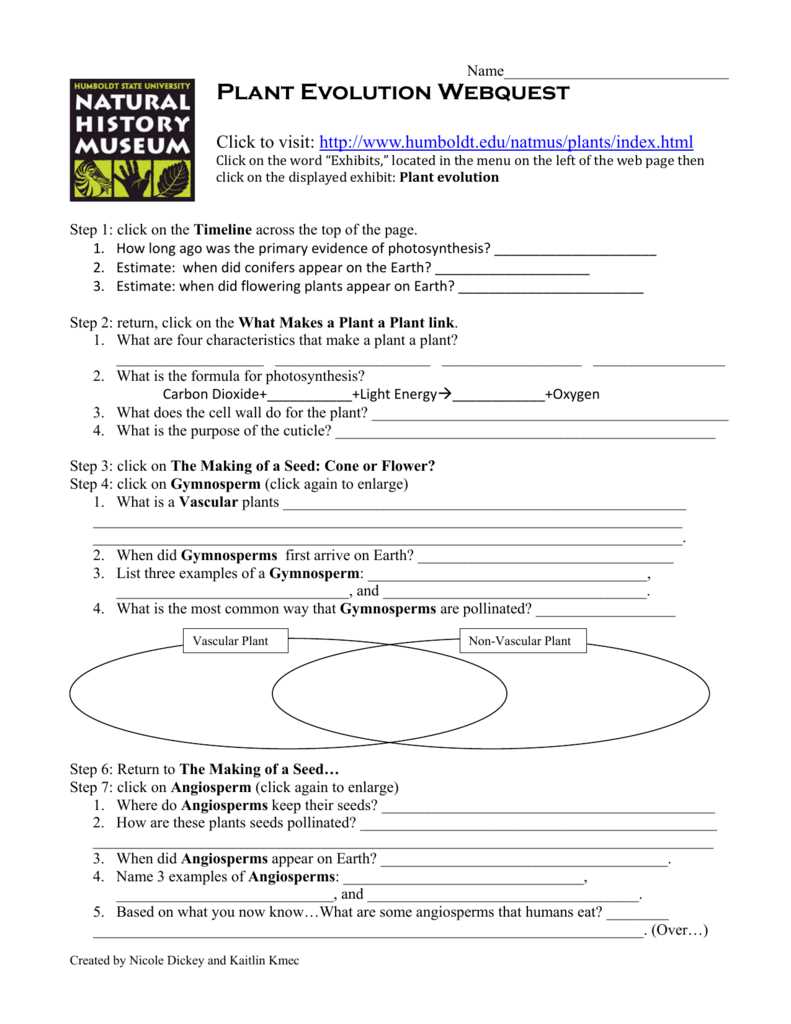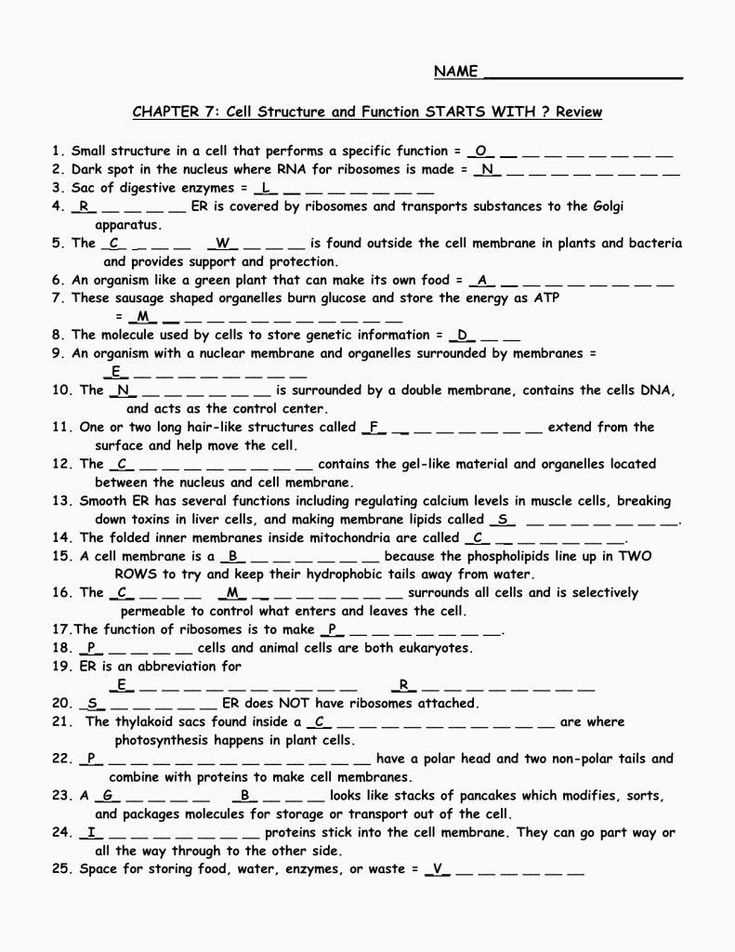
In the field of biology, cell transport refers to the movement of materials across the cell membrane. This process is crucial for the survival and functioning of cells, as it allows them to obtain necessary nutrients, expel waste, and maintain homeostasis. Understanding the mechanisms and factors involved in cell transport is essential for comprehending how cells function and interact with their environment.
Cell transport can occur through various mechanisms, such as passive transport, active transport, and bulk transport. Passive transport does not require energy and includes processes like diffusion and osmosis. Active transport, on the other hand, requires energy and involves the movement of molecules against their concentration gradient. Bulk transport refers to the transportation of large molecules or particles through endocytosis or exocytosis.
A webquest is a valuable tool for exploring and learning about cell transport. It involves students navigating a series of online resources, answering questions, and synthesizing information to build their understanding. This answer key provides the responses to the questions posed in the cell transport webquest, allowing students to check their answers and further deepen their knowledge on the topic.
Cell Transport Webquest Answer Key: An Overview
In the Cell Transport Webquest, you were tasked with exploring the different types of cellular transport mechanisms, including diffusion, osmosis, and active transport. You used interactive resources, videos, and quizzes to gather information and complete the webquest. Now, let’s go over the answer key that provides the correct responses to the questions you encountered during your exploration.
Diffusion is the movement of molecules from an area of high concentration to an area of low concentration. This process does not require energy and occurs until equilibrium is reached. Osmosis, on the other hand, is the diffusion of water molecules through a selectively permeable membrane. It also goes from an area of higher water concentration to an area of lower water concentration.
- In the webquest, you were asked about the difference between isotonic, hypotonic, and hypertonic solutions. An isotonic solution has the same concentration of solutes as the cell, resulting in no net movement of water. A hypotonic solution has a lower solute concentration than the cell, causing water to enter the cell and potentially burst it. A hypertonic solution has a higher solute concentration than the cell, causing water to leave the cell and potentially shrink it.
- Another question addressed active transport, which requires energy to move molecules against their concentration gradient. This process is carried out by specific proteins called pumps. One example of active transport is the sodium-potassium pump, which moves sodium ions out of the cell and potassium ions into the cell. This creates an electrochemical gradient that is vital for various cellular functions.
- The webquest also covered endocytosis and exocytosis. Endocytosis is the process by which a cell takes in large molecules or particles by engulfing them with its membrane. Exocytosis, on the other hand, is the process by which a cell releases substances from its membrane-bound vesicles into the extracellular space.
By completing the Cell Transport Webquest and reviewing the answer key, you have gained a deeper understanding of how cells maintain homeostasis through the different types of transport mechanisms. This knowledge is crucial for comprehending the vital role that cell transport plays in various physiological processes and the overall function of living organisms.
What is Cell Transport?
Cell transport refers to the mechanisms and processes by which cells move molecules and substances across their membrane. It is crucial for cell survival and the functioning of organisms as a whole. Cells need to take in nutrients, eliminate waste products, and communicate with other cells, and cell transport allows them to do so efficiently and selectively.
There are two main types of cell transport: passive transport and active transport. Passive transport does not require energy and includes processes such as diffusion, osmosis, and facilitated diffusion. These processes rely on the concentration gradient and the permeability of the cell membrane to move molecules from an area of high concentration to an area of low concentration.
On the other hand, active transport requires energy in the form of ATP and enables cells to move molecules against their concentration gradient. This can be achieved through processes such as active transport pumps, endocytosis, and exocytosis. Active transport allows cells to accumulate essential nutrients, expel waste products, and maintain specific concentrations of ions and molecules within the cell.
Overall, cell transport is a fundamental aspect of cellular biology, as it allows cells to maintain homeostasis, communicate with their environment, and carry out essential functions for organism survival.
Why is Cell Transport Important?
The process of cell transport is essential for the survival and functioning of living organisms. It allows cells to maintain homeostasis, exchange materials with their environment, and communicate with other cells. Without proper cell transport mechanisms, cells would not be able to receive the necessary nutrients, eliminate waste products, or coordinate their activities.
One key aspect of cell transport is the movement of molecules across the cell membrane. Through processes such as diffusion, osmosis, and active transport, cells can regulate the concentration of substances inside and outside the cell. This is crucial for maintaining the right balance of ions, water, and other molecules necessary for cellular activities. For example, cells need to constantly pump out excess ions to prevent an imbalance that could disrupt cellular processes.
In addition to regulating the internal environment of cells, cell transport mechanisms also allow for the transmission of signals between cells. This is important for coordinating the activities of different cells within tissues and organs. For instance, nerve cells rely on ion channels and membrane transporters to generate and transmit electrical signals, which are essential for the functioning of the nervous system. Similarly, cells of the immune system use cell transport to communicate and respond to invading pathogens.
In summary, cell transport is vital for the proper functioning of cells and organisms. It allows cells to maintain homeostasis, regulate the concentration of molecules, and communicate with other cells. Understanding the various mechanisms of cell transport is crucial for advancing our knowledge of biological processes and developing treatments for diseases related to cell dysfunction.
Key Concepts in Cell Transport Webquest Answer Key

In the Cell Transport Webquest, we covered several key concepts related to how substances move across the cell membrane. These concepts include passive transport, active transport, and the different mechanisms involved in each process.
Passive transport: This is the movement of substances across the cell membrane without the input of energy. It occurs down the concentration gradient, from an area of high concentration to an area of low concentration. Within passive transport, there are two main types: diffusion and osmosis. Diffusion is the movement of molecules from an area of high concentration to an area of low concentration. Osmosis, on the other hand, is the movement of water molecules across the membrane to equalize the concentration of solutes.
Active transport: This is the movement of substances across the cell membrane with the input of energy, usually in the form of ATP. Unlike passive transport, active transport occurs against the concentration gradient, from an area of low concentration to an area of high concentration. Active transport allows cells to maintain a concentration gradient that is necessary for various cellular functions.
There are several mechanisms involved in active transport, including protein pumps and endocytosis/exocytosis. Protein pumps are integral membrane proteins that utilize ATP to pump specific molecules or ions across the membrane. Endocytosis is the process of taking in substances by engulfing them with the cell membrane, forming vesicles. Exocytosis, on the other hand, is the process of releasing substances from the cell by fusing vesicles with the cell membrane.
Overall, understanding these key concepts in cell transport is essential to comprehend how substances are transported in and out of cells. Passive transport and active transport play crucial roles in maintaining homeostasis and ensuring the proper functioning of cells.
Passive Transport
Passive transport is a biological process that does not require the input of energy. It relies on the inherent properties of molecules and the concentration gradient across a cell membrane to allow substances to move in and out of the cell. There are three main types of passive transport: diffusion, osmosis, and facilitated diffusion.
Diffusion is the movement of molecules from an area of higher concentration to an area of lower concentration. This process occurs spontaneously and is driven by the random motion of molecules. Diffusion plays a crucial role in the movement of gases such as oxygen and carbon dioxide across cell membranes.
Osmosis is a special type of diffusion that involves the movement of water molecules across a selectively permeable membrane. Water will move from an area of lower solute concentration to an area of higher solute concentration, in an attempt to equalize the concentration of solutes on both sides of the membrane. Osmosis is important for maintaining the balance of water in cells and is essential for proper cell function.
Facilitated diffusion is the passive transport of molecules across a cell membrane with the help of transport proteins. These proteins create channels or carrier proteins that allow specific molecules to pass through the membrane. Facilitated diffusion is necessary for the movement of larger molecules, such as glucose, across cell membranes, as they are unable to pass through the lipid bilayer on their own.
Overall, passive transport is a vital process for cells to maintain homeostasis and regulate the movement of necessary molecules across their membranes. It allows cells to efficiently and selectively transport substances without expending energy.
Active Transport

Active transport is a process in which cells move molecules or ions against a concentration gradient, from an area of lower concentration to an area of higher concentration. Unlike passive transport, which relies on the natural movement of molecules down a concentration gradient, active transport requires the use of energy in the form of ATP.
One example of active transport is the sodium-potassium pump, which is found in the plasma membrane of all animal cells. This pump moves sodium ions out of the cell and potassium ions into the cell, against their respective concentration gradients. This process is essential for maintaining the proper balance of these ions and is involved in many cell functions, including nerve cell signaling and muscle contraction.
In addition to the sodium-potassium pump, active transport is also involved in the uptake of essential nutrients, such as glucose, by cells. For example, in the small intestine, there is a sodium-glucose co-transporter that allows glucose to be actively transported into cells, against its concentration gradient. This is important for the absorption of glucose from the digestive system into the bloodstream.
Overall, active transport plays a crucial role in maintaining the internal environment of cells and ensuring that necessary molecules and ions are properly transported across cell membranes. It requires energy input and is selective in the molecules and ions it transports. Without active transport, many cellular processes would not be possible and cells would not be able to survive.
Facilitated Diffusion
Facilitated diffusion is a type of passive transport in cells that relies on the assistance of transport proteins to move molecules across the cell membrane. This process does not require the expenditure of energy by the cell.
Facilitated diffusion occurs when molecules are too large or too hydrophilic to pass through the lipid bilayer of the cell membrane. Instead, these molecules bind to specific transport proteins embedded in the cell membrane. The transport proteins create a channel or pore that allows the molecules to pass through the membrane.
Transport Proteins:
Transport proteins involved in facilitated diffusion are often called carrier proteins or channel proteins. Carrier proteins bind to the specific molecules they are designed to transport and undergo a conformational change to move the molecules across the membrane. Channel proteins, on the other hand, create a continuous pathway or pore through which molecules can pass.
Factors Affecting Facilitated Diffusion:
The rate of facilitated diffusion is influenced by several factors, including the concentration gradient of the molecules, the number of transport proteins available, and the affinity between the transport proteins and the molecules they are transporting. Higher concentration gradients, more transport proteins, and stronger affinity result in faster facilitated diffusion.
- Concentration gradient: The greater the difference in concentration between the inside and outside of the cell, the faster the molecules will diffuse.
- Number of transport proteins: More transport proteins increase the rate of diffusion as there are more pathways available for the molecules to move through.
- Affinity between proteins and molecules: Stronger affinity between the transport proteins and the molecules enhances the binding and transport process.
Overall, facilitated diffusion is a crucial process for the movement of certain molecules across the cell membrane, ensuring the proper functioning of cells and maintaining cellular homeostasis.
Components of Cell Transport Answer Key
The cell transport process is a vital mechanism for the survival and functioning of cells. It involves the movement of substances across the cell membrane to maintain proper cellular homeostasis. Understanding the components of cell transport is crucial for comprehending how cells transport molecules and ions.
The key components of cell transport include:
- Cell Membrane: The cell membrane is a semi-permeable barrier that surrounds the cell and regulates the passage of substances in and out of the cell. It is composed of a lipid bilayer with embedded proteins that serve various transport functions.
- Transport Proteins: These proteins are embedded in the cell membrane and facilitate the movement of molecules and ions across the membrane. There are two types of transport proteins: channel proteins, which form open channels for specific molecules to pass through, and carrier proteins, which undergo a conformational change to transport molecules across the membrane.
- Passive Transport: Passive transport is the movement of molecules and ions across the cell membrane without the use of energy. It occurs through diffusion, osmosis, and facilitated diffusion. Diffusion is the movement of molecules from an area of high concentration to low concentration, while osmosis is the diffusion of water molecules across a selectively permeable membrane. Facilitated diffusion involves the use of transport proteins to facilitate the movement of molecules.
- Active Transport: Active transport is the movement of molecules against their concentration gradient, from an area of low concentration to high concentration. This process requires energy in the form of ATP and involves the use of specific transport proteins called pumps to transport molecules across the cell membrane.
- Endocytosis and Exocytosis: Endocytosis is the process by which cells engulf external substances by forming a vesicle around them and bringing them into the cell. Exocytosis is the opposite process, where cells release materials by fusing vesicles with the cell membrane and releasing their contents outside of the cell.
By understanding these key components, scientists can gain insights into the intricate mechanisms by which cells transport substances and maintain their internal environment.